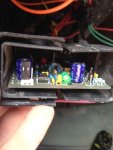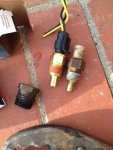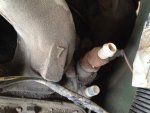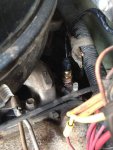Today I tackled the M1031 SECM governor issue. It never worked quite right from when it was recovered at Ft. McCoy. Instead of brute force troubleshooting, I went with the basics. It is a 12 volt powered device so it needs 12 volts, only thing was it was only getting barely 10 volts and sometimes as low as 8. Well, there's the problem!!!
I traced down the circuit diagram and found the fuse in the control panel to have about 3/4 volt of voltage drop. Not enough to matter but every bit counts. I cleaned it up, eliminating measurable loss. But still a problem...it is getting 14.4 volts at the fuse block...wait, is that ANOTHER inline fuse? Whiskey tango foxtrot? Well, that is where it needs to be but could it also be bad? Sure enough, it was the culprit. Measured over 1 ohm of resistance and had a solder blob leaking from one end

. Not having antique fuses, it was desoldered on the bad end, then put back together for a temp fix.
Like magic, the governor works like a CHARM!!!!! Still need a fine tune under load but it is all functional.
Needless to say, that meant the truck was running a bit and so I noticed an oil leak, from the oil cooler fittings on the left side by the radiator and AOAP sampling port. Son of a gun, hydraulic fittings... I got wrenches and discovered it was a bum o-ring, twisted from day one install. No problem, I have a complete set of Viton rings as this is the contact truck. Got that fixed easily. This troubled me as I never saw a leak at idle but noticed excessive oil consumption. I have been coating Texas in 15W40 for almost two years. Nevermore...
Still need to test the alternator outputs as they seem weak with my 24 volt air conditioning upgrade. The motor driving compressor is rated at 70 amps doing 3000 RPM, I am getting 2950 RPM on it so it isn't overloaded too much. Voltmeter barely stays in the green when doing 55 MPH so I know they are NOT putting out 100 amps. Probably aging rectifiers.




 . Not having antique fuses, it was desoldered on the bad end, then put back together for a temp fix.
. Not having antique fuses, it was desoldered on the bad end, then put back together for a temp fix. 






